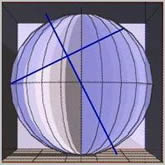Squaring the Circle 396 x 8 = 3168
Squaring the Circle — 396 × 8 = 3168
The Ancient Puzzle
"Squaring the circle" means constructing a square with the same area as a given circle using only compass
and straightedge.
This is impossible in exact terms because π is irrational — but approximations and symbolic explorations
have fascinated people for centuries.
The number 3168 appears in interesting ways:
In biblical numerology, the full title "Lord Jesus Christ" (Greek ΚΥΡΙΟΣ ΙΗΣΟΥΣ ΧΡΙΣΤΟΣ) has gematria
value 3168 (396 x 8)
Geometrically: a circle with circumference 3168 units has diameter ≈ 1008 (3168 ÷ π ≈ 1008.4), a number
associated with completion and abundance in some traditions.
This isn't a mathematical solution — it's a symbolic "echo" blending numbers, geometry, and meaning.
Practical Approximations
Using compass and straightedge, you can build constructions that make a square and circle with very
close areas.
One method uses multiple circles and guide lines to achieve accuracy up to 99.999995% or better.
Another easier method gives ~99.9% accuracy.
These show how close we can get — turning the impossible puzzle into a fun, high-precision exercise.
Open Wonder
Numbers like 396, 8, and 3168 connect math, geometry, and symbolism in surprising ways.
No proof of deeper meaning — just patterns inviting thought.
Place 8 circles along the X-axis and 2.5 on the Y-axis, and add guide-line A.
Connect a line starting from b (diagram 1) to c (on the Y-axis), touching the circle at "e"
as accurately as possible. Important! The accuracy of the final result depends on it.
Draw the line e-f parallel to the X-axis, and circle radius o-f.
Draw circle 1 (radius u-o), then 2, then add guide line B.
Circle radius q-m as shown (q = B guide line and circle). It produces point h, and the inner circle.
Circle radius o-h and draw guide line C through point i.
Intersection of guide lines C and A is z.
Draw line b-z = the circle radius.
Circle area (radius b-z) 2 x π should closely match Square area (line a-b x 2) 2
Doing this by compass and pencil one can get a quite accurate result,
by drawing the C guide line just below the top of the upper circle.
There are a few variation possibilities to this construction method.
><><
Lastly, a less accurate but easier and fun construction method where (A-D)2 + (D-B)2 = (A-B)2 :
1. Draw circles 1, 2, 3
2. Draw triangle and post.
3. Draw guide lines as shown.
Circle radius A-B = √10 000 000 mm. Area = π x 10 000 000 (31415926.535... mm)
A-C = 2800 mm, and a square area of (2800 x 2) 2 = 31360000 mm
Accurate to 99.9%
What connections do you see?
